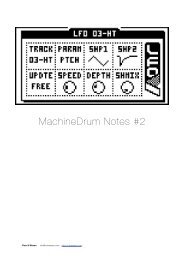MachineDrum Notes #1 - Ruin & Wesen
MachineDrum Notes #1 - Ruin & Wesen
MachineDrum Notes #1 - Ruin & Wesen
You also want an ePaper? Increase the reach of your titles
YUMPU automatically turns print PDFs into web optimized ePapers that Google loves.
Pattern C16<br />
I started producing techno on the <strong>MachineDrum</strong> after being deeply impressed by Richie Hawtin’s liveset CD “DE9 -<br />
Closer to the Edit”, which mixes a different short loops from minimal techno records into a brilliantly constructed set.<br />
A lot of the sounds are very short, using simple rhythmic patterns, but the layers are constantly shifting in and out.<br />
The simple patterns produce a very hypnotic kind of feeling, and the huge dynamics and organic sounds make for<br />
music you can dance too, think to, dream to.<br />
I started building very simple rhythmic patterns, and recorded each track into a loop. I then spent some time in<br />
Ableton arranging these loops, then exporting the Ableton liveset and reimporting it as different patterns into the MD<br />
(one pattern per row of arranged clips). I hacked this functionality together and will try to make it usable for other<br />
people, but it’s in a very rough state. This process was a big help because it allowed me to try new things out, work<br />
out different mixes and progressions between the loops. C16 is one of the patterns that was left over from one of<br />
these exploration sessions and then constantly evolved over the next livesets. After 8 months of playing with it, it is<br />
still one of my favorite patterns because of the very “lively” nature of the sounds. The simple rhythmic patterns allow<br />
me to focus a lot on the sound of the track itself, and tweak a lot of the sounds in a subtle way.<br />
While analyzing Closer to the Edit, I also realized that to sound like techno, it is easiest to follow some rules. Of<br />
course, this sounds obvious, but it was a big revelation at the time. It is also very important to break exactly these<br />
genre rules to move forward. But I still am using the prototypical schema of having a bassdrum on every beat (four to<br />
the floor), an offbeat hihat, and a snare on 2 and 4. Of course, I vary these rules, but this is the basic schema I follow.<br />
This is not very innovative, but it allows me have a framework in which I can work. The basic rhythm is given, and I<br />
can focus on the sounds in between, on the dynamics, on the sounds.<br />
I am using the sound description I have on my liveset cheatsheets in the description below.<br />
Track 1: Bassdrum<br />
This is my prototypical bassdrum. I usually just copy paste this sound over and over, because it turned out to be a<br />
functional one. It is quite deep, but short, and not very loud, done using TRX-BD. I experimented a bit with other<br />
bassdrum, but decided to stick with the round sound of this one.<br />
You can see that the volume is at 62. It took me a long time to achieve a kind of subtle organic sound on the<br />
<strong>MachineDrum</strong> (of course, I am still working a lot on it), and a key to achieve this was to turn down the volume on a<br />
lot of elements. While playing, I usually don’t tweak the bassdrum, just either mute it, or high-pass filter it to make<br />
transitions and breaks.<br />
<strong>Ruin</strong> & <strong>Wesen</strong> info@ruinwesen.com http://ruinwesen.com/




